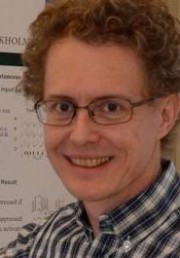KTH neuroscience researcher expands on Nobel discovery
The Nobel laureates’ discovery of the brain’s inner GPS system has been a major breakthrough in understanding how the brain works. At KTH Royal Institute of Technology, Erik Fransén has stepped through the doors they opened with his work in computational neuroscience.
By discovering the cells that enable our brain’s positioning system, John O'Keefe, May-Britt Moser and Edvard Moser have opened doors to a deeper understanding of how specialised cells work together to carry out higher cognitive functions, such as navigation.
One scientist who can appreciate their achievement is Fransén, a researcher in computational neuroscience and computational neuropharmacology at KTH who has examined the properties of grid cells and place cells.
Fransén is one of four scientists who in 2007 jointly proposed a hypothesis in Science explaining how grid cells obtain their properties. In another paper, he and his researcher partners linked the properties of grid cells to memory, which is another crucial function the entorhinal cortex serves along with the hippocampus.
He says the findings of O'Keefe and the Mosers are important because they provide us with examples of the way the brain codes our place in the world.
“This is a big question: how the brain produces an internal model of the world and what the code for this looks like,” Fransén says.
In doing so, the scientists “solved a problem that has occupied philosophers and scientists for centuries”, said the Karolinska Institutet in Stockholm, which selects the laureates. “How does the brain create a map of the space surrounding us and how can we navigate our way through a complex environment?”
A place cell will fire its nerve impulses when an animal is in a particular spot, Fransén explains. This location is called the “place field” of the neuron. The neuron also codes whether the animal moves towards or away from the place field. A grid cell, which builds a sort of navigational map, sends nerve impulses when the animal is located in any of the locations on the grid.

“So, if you draw a line between three such nearby locations, it will form a perfect unilateral triangle,” he says. “It looks like a triangular coordinate system. In one end of the entorhinal cortex, the distance between locations is small, and then when you observe cells going towards the other end of the brain area, the distance gets progressively larger.
“At the end of large distances, you get information about the big picture – where you are, generally speaking; and in the other end you get accurate information about your position.”
The discovery set the stage for other questions to be tackled. Such as what determines the distance between the locations on the grid? In his research, Fransén and his colleagues have found that, contrary to prevailing belief that it comes from the interplay of millions of neurons in the entorhinal cortex, the property of each neuron is changing from one end of the entorhinal cortex to the other.
Fransén says his team attributed this property of the function of a single type of ion channel, one of the key building blocks of neurons. By using computational models of how biophysics in nerve cells work, they showed how the peculiar property of the ion channel provides the neuron with a property enabling it to interact with other neurons in a unique way.
“In the model, we connected neurons, both place cells and grid cells, according to anatomical data of hippocampus and entorhonal cortex”, Fransén says. “When we used the data from a study by the laureates Moser & Moser of how a rat moves, the model produced grid cell activity like the data of the very same animal.
“In this way the model enables us to connect data from different experiments and to study the outcome of molecular actions on neural activity and on animal behaviour,” he says.
In 2009 he co-authored a study that took the model one step further. They linked the properties of the grid cells to data from learning and memory experiments. In the model of the brain they produced, they were able to show how neuronal networks that produced grid cell activity also could produce neural activity resembling the activity seen in animals, both when they learn, and after learning – when the animal sleeps and the brain processes the newly-learned information
“Computational models have become indispensable tools to test hypotheses of brain function,” Fransén says.

